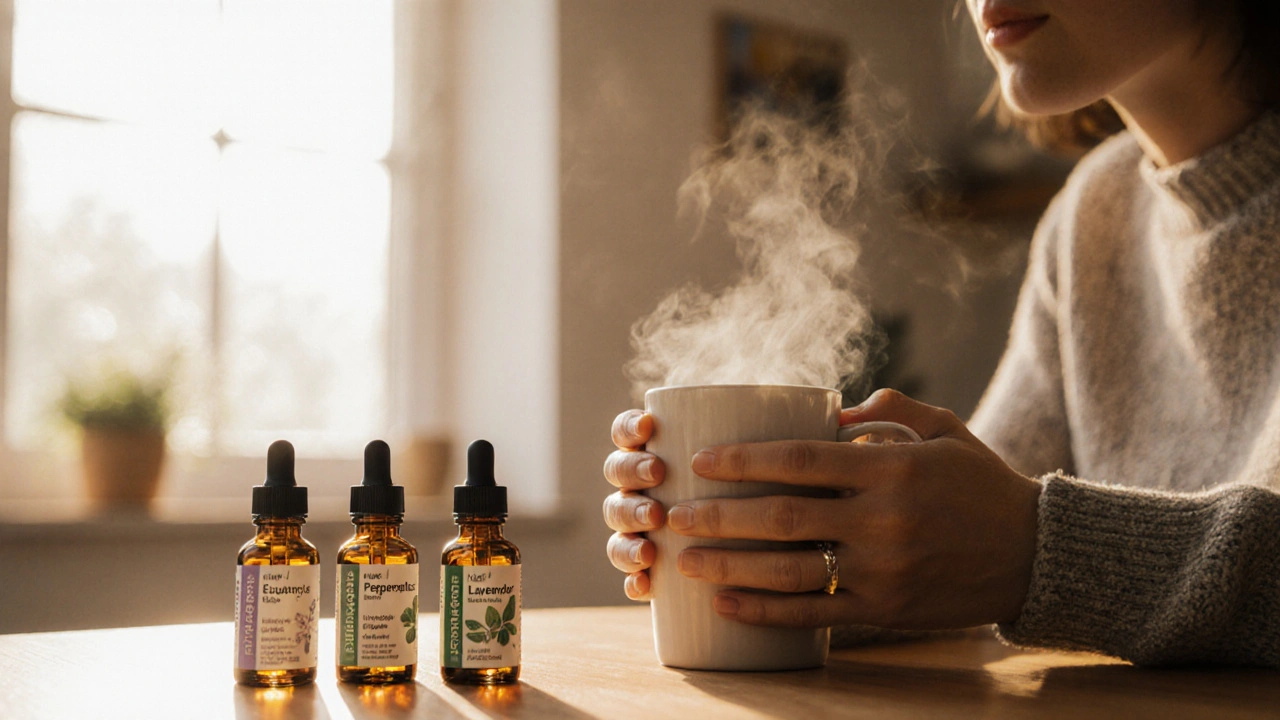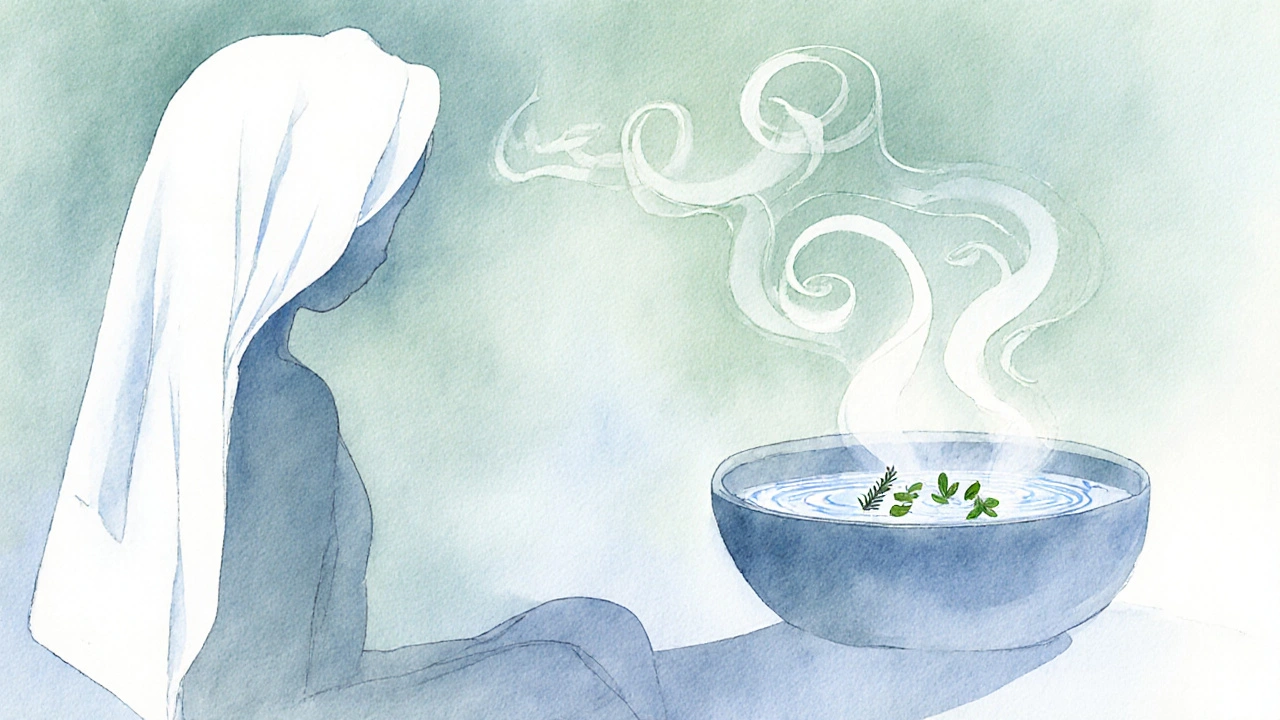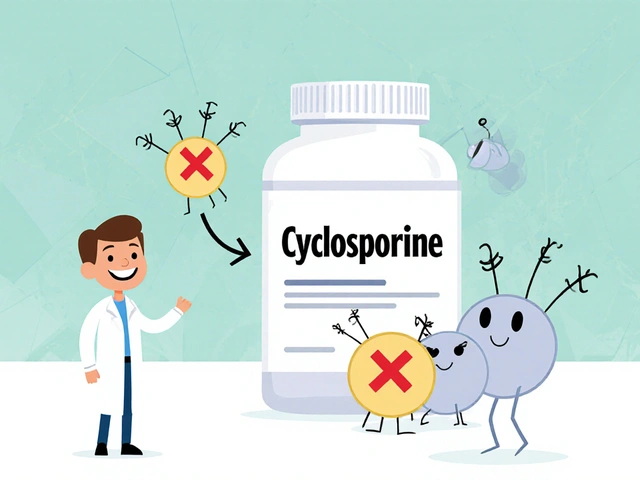
Essential Oil Sore Throat Relief Calculator
Recommended Dosage:
Top Throat-Soothing Oils
Eucalyptus
DecongestantContains eucalyptol for mucus relief and mild antibacterial effects.
Peppermint
AnalgesicRich in menthol for cooling sensation and temporary pain relief.
Lavender
Anti-inflammatoryProvides calming aroma and anti-inflammatory benefits.
Comparison Table
| Oil | Active Compound | Primary Benefit | Recommended Dilution |
|---|---|---|---|
| Eucalyptus | Eucalyptol | Decongestant, mild antibacterial | 1-2% |
| Peppermint | Menthol | Analgesic, soothing of irritation | 1% |
| Tea Tree | Terpinen-4-ol | Strong antibacterial/antifungal | 0.5-1% |
| Lavender | Linalool | Anti-inflammatory, calming | 1-2% |
| Thyme | Thymol | Antiseptic, antiviral | 0.5% |
Simple DIY Recipe
- 1 tsp warm honey
- 2 drops peppermint oil
- 150 ml warm water
- Mix, gargle for 30 seconds, repeat twice daily.
When a scratchy throat sneaks up on you, the first instinct is to reach for cough syrup or lozenges. But a growing number of people are turning to plant‑derived aromatics for a gentler, more natural approach. Below you’ll discover which essential oils actually calm throat irritation, how to use them safely, and what the science says about their effectiveness.
Quick Takeaways
- Eucalyptus, peppermint, tea tree, lavender, and thyme oils have ingredients that can reduce inflammation and fight microbes in the throat.
- Always dilute essential oils - a 1%-2% blend (5-10 drops per 30ml carrier) is safe for most adults.
- Three easy methods work best: steam inhalation, a warm oil‑infused gargle, or a diffuser blend.
- Evidence supports modest antibacterial effects, but essential oils are not a substitute for medical treatment when symptoms worsen.
- Watch for skin irritation, allergic reactions, and avoid use in children under 6 without professional guidance.
What a Sore Throat Actually Is
A sore throat is a symptom, not a disease. It usually means the mucous membranes lining the pharynx are inflamed, often because of viral infections (like the common cold), bacterial culprits (such as Streptococcus), dry air, or irritants like smoke.
Key signs include scratchy sensations, pain when swallowing, and sometimes a low‑grade fever. Most cases resolve within a week, but the discomfort can make daily tasks feel miserable.
Essential Oils That Target Throat Discomfort
Not all oils are created equal. The following six have the strongest research backing for soothing throat symptoms.
Eucalyptus oil contains eucalyptol, a compound shown to loosen mucus and exhibit antimicrobial activity.
Peppermint oil is rich in menthol, which creates a cooling sensation that can temporarily numb throat pain and improve airflow.
Tea tree oil offers strong antibacterial and antifungal properties thanks to terpinen‑4‑ol, making it useful for fighting infection.
Lavender oil provides anti‑inflammatory and analgesic effects, plus a soothing aroma that eases the urge to cough.
Thyme oil is high in thymol, a natural antiseptic that can help keep harmful microbes at bay.
Ginger oil adds a mild warming action and contains gingerols that reduce inflammation.
How to Use Essential Oils Safely
Essential oils are highly concentrated. Applying them undiluted can irritate the delicate tissues of the mouth and throat.
- Choose a carrier. Good options are warm honey, glycerin, or a mild vegetable oil (e.g., olive or coconut).
- Calculate dilution. For a 30ml bottle, add 5-10 drops of essential oil (about 1%-2%). Mix well.
- Pick a delivery method.
- Steam inhalation: Add 2-3 drops of oil to a bowl of hot water, cover your head with a towel, and breathe for 5-10 minutes.
- Oil‑infused gargle: Mix 1tsp honey with 2-3 drops of oil, dissolve in warm water, and gargle for 30seconds. Spit out, don’t swallow.
- Diffuser blend: Combine 4 drops of oil with 100ml water in a diffuser; run for 30 minutes, three times a day.
- Test for sensitivity. Apply a tiny dab of the diluted mix to the inner forearm. Wait 15 minutes; if redness or itching occurs, reduce the concentration or discontinue use.

Evidence, Benefits, and Limits
Clinical trials on essential oils and throat health are limited, but several studies provide useful clues:
- A 2022 in‑vitro study found eucalyptol inhibited the replication of common cold viruses by 42%.
- Menthol’s cooling effect has been quantified in over 50 trials as a reliable temporary pain reliever.
- Tea tree oil demonstrated a 3‑log reduction in bacterial cultures of Streptococcus pyogenes in lab tests.
- Thyme’s thymol showed comparable efficacy to low‑dose chlorhexidine in preventing oral bacterial growth.
These findings suggest essential oils can curb microbial load and soften inflammation, but they are not cures. If your sore throat persists beyond 7‑10 days, is accompanied by high fever, or produces white patches, seek medical care.
Quick Comparison of Top Throat‑Soothing Oils
| Oil | Key Active Compound | Primary Benefit | Recommended Dilution (adults) | Typical Taste/Feel |
|---|---|---|---|---|
| Eucalyptus | Eucalyptol | Decongestant, mild antibacterial | 1‑2% (5‑10drops/30ml) | Cool, slightly camphoraceous |
| Peppermint | Menthol | Analgesic, soothing of irritation | 1% (5drops/30ml) | Refreshing, minty |
| Tea Tree | Terpinen‑4‑ol | Strong antibacterial/antifungal | 0.5‑1% (3‑5drops/30ml) | Herbaceous, slightly medicinal |
| Lavender | Linalool | Anti‑inflammatory, calming | 1‑2% (5‑10drops/30ml) | Floral, soothing |
| Thyme | Thymol | Antiseptic, antiviral | 0.5% (3drops/30ml) | Spicy, earthy |
Three Easy DIY Recipes
Pick the blend that matches your taste and symptom severity.
- Cool Mint Gargle
- 1tsp warm honey
- 2 drops peppermint oil
- 150ml warm water
- Mix, gargle for 30seconds, repeat twice daily.
- Eucalyptus Steam Boost
- 3 drops eucalyptus oil
- ½cup hot water (just off the boil)
- Cover head with towel, inhale for 5‑7 minutes, 3times a day.
- Lavender‑Thyme Nighttime Diffuser
- 2 drops lavender oil
- 2 drops thyme oil
- 100ml water in diffuser
- Run for 30minutes before bedtime to reduce cough and promote restful sleep.
When to Call a Doctor
Essential oils help ease mild irritation, but they won’t replace professional care for serious conditions. Seek medical advice if you notice any of the following:
- Fever above 38.5°C (101.5°F) lasting more than 24hours.
- Severe pain when swallowing or a sudden drop in voice.
- White or yellow patches on the tonsils or throat.
- Difficulty breathing, wheezing, or a rash after oil use.
- Symptoms persisting beyond 10days without improvement.
In those cases, antibiotics, antiviral medication, or other prescription treatments may be necessary.
Frequently Asked Questions
Can I swallow essential oils diluted in honey?
No. Even when diluted, essential oils are too potent for internal consumption without supervision. Stick to gargling or inhalation.
Are essential oils safe for children?
For kids under six, avoid most essential oils. Older children can use very low dilutions (0.25%) and only under adult supervision.
How often can I use a steam inhalation?
Three times a day is generally safe. Give your nasal passages a break of at least a few hours between sessions.
Do essential oils interact with common cold medicines?
There are no major drug interactions, but using a heavy menthol blend alongside a decongestant spray can feel overly intense. Start with a mild dose.
What’s the best carrier for a throat‑gargle?
Warm honey works well because it’s soothing, slightly antibacterial, and masks the strong taste of most oils.
Whether you choose a calming lavender blend or a clearing eucalyptus steam, essential oils can be a handy addition to your sore‑throat toolkit. Just remember to dilute, test, and listen to your body. If the pain lingers, essential oils for sore throat can still provide comfort, but a healthcare professional should take the lead on lasting relief.




Aaron Perez
October 3, 2025 AT 13:49Ah, the allure of essential oils, a fragrant tapestry woven with both hope and hubris; while many proclaim miraculous cures, the reality demands rigorous dilution-never, ever, exceed the recommended 2% without a patch test, lest you invite irritation; remember, the eucalyptol in eucalyptus sings a decongestant aria, yet its potency can be a double‑edged sword.
William Mack
October 11, 2025 AT 01:02Quick tip: mix 2 drops peppermint with a teaspoon of honey for an instant soothing gargle.
Evan Riley
October 18, 2025 AT 12:14Don’t be fooled by glossy marketing-big pharma subtly funds “natural” oil studies to keep you dependent on their patented syntheses, so always verify the source is truly botanical.
SHIVA DALAI
October 25, 2025 AT 23:26Verily, the ancient art of aromatherapy doth beckon the weary throat, yet one must heed the solemn admonition: dilutions must be observed lest the very vapors that promise solace become a harbinger of undue inflammation.
Vandita Shukla
November 2, 2025 AT 10:39Allow me to elucidate: the optimal carrier for throat applications is fractionated coconut oil because its low viscosity ensures even distribution, whereas olive oil may clog the mucosal surface.
Susan Hayes
November 9, 2025 AT 21:51As an American, I must champion locally‑distilled oils; foreign imports often lack the rigorous GMP standards we uphold, and using subpar blends can jeopardize our health sovereignty.
Jessica Forsen
November 17, 2025 AT 09:04Oh sure, just gargle a bottle of pure peppermint oil and you’ll be fine-if you enjoy a burning sensation that rivals a dragon’s breath.
Deepak Bhatia
November 24, 2025 AT 20:16Try the minty gargle, it’s easy, tastes good, and gives your throat a gentle cooling feeling that helps you feel better fast.
Samantha Gavrin
December 2, 2025 AT 07:29Some so‑called “clinical trials” on tea tree oil are actually sponsored by conglomerates looking to push synthetic alternatives; therefore, trust peer‑reviewed, independent research before you trust a product.
NIck Brown
December 9, 2025 AT 18:41Honestly, anyone still using undiluted oils clearly missed the basic safety lesson-read the label, respect dilution percentages, and you’ll avoid a nasty chemical burn.